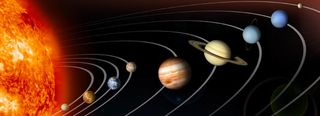NASA Shortlists 3 Ambitious Planetary Missions for 2016 Launch

Three ambitious space missions have made NASA's shortlist for a planned robotic planetary expedition to launch in 2016. The candidates include a mission to glimpse Mars' interior, a voyage to the extraterrestrial sea of Saturn's moon Titan, and a probe to take an unprecedented look at the surface of a comet's core.
Ultimately, only one mission will win the coveted rocket launch, NASA officials said. The investigation team for each mission proposal will receive $3 million for a preliminary design stage, they added.
After NASA reviews these concept studies, the space agency will choose one to continue development leading up to launch as part of NASA's Discovery Program, whose missions have included the Messenger probe to Mercury, the asteroid-chasing Dawn spacecraft, as well as the agency's Stardust, Deep Impact and Genesis probes. The final mission will have a fixed budget of $425 million, not including the cost of its launch vehicle.
"This is high science return at a price that's right," Jim Green, director of NASA's Planetary Science Division in Washington, said in a statement. "The selected studies clearly demonstrate a new era with missions that all touch their targets to perform unique and exciting science."
Here's a look at the three space mission candidates on NASA's shortlist:
- The Geophysical Monitoring Station (GEMS), which would study the structure and composition of the interior of Mars, potentially improving our understanding of the formation and evolution of terrestrial planets;
- The Titan Mare Explorer (TiME), which would land in and float on a large methane-ethane sea on Saturn's moon Titan, providing the first direct exploration of an ocean beyond Earth; [Video: Targeting Saturn's Moon Titan: Land, Sea and Air]
- And Comet Hopper, which would land on a comet multiple times and observe its changes as it interacts with the sun.
Their selection for further study comes two months after the release of an in-depth report from the National Research Council into the greatest needs for planetary exploration in the next decade. The review noted that NASA's Discovery Program of low-cost, highly focused planetary science investigations has made key contributions to science and should be continued at its current level of funding with adjustments for inflation.
However, the report also expressed concern over NASA's ability to fund its most ambitious planet exploration flights given its current budget constraints.
Get the Space.com Newsletter
Breaking space news, the latest updates on rocket launches, skywatching events and more!
In addition, the Discovery Program also chose three space technology developments for potential future planetary missions.
These include:
- NEOCam: A telescope to analyze near-Earth objects, study their origin and evolution, and monitor their risk of impacting our planet;
- Primitive Material Explorer (PriME): A mass spectrometer that would yield highly precise measurements of a comet's chemical composition and explore comets' role in delivering the potential ingredients of life to Earth;
- Whipple: An effort to develop and test a technique called blind occultation to discover and investigate celestial objects in the outer solar system.
In upcoming years, research teams will bring their respective technologies to a higher level of readiness, receiving funding determined through contract negotiations. They must demonstrate progress in a future mission proposal competition to be considered for flight.
"NASA continues to do extraordinary science that is rewriting textbooks," NASA Administrator Charles Bolden said in a statement. "Missions like these hold great promise to vastly increase our knowledge, extend our reach into the solar system and inspire future generations of explorers."
Follow SPACE.com contributor Charles Q. Choi on Twitter @cqchoi. Visit SPACE.com for the latest in space science and exploration news on Twitter @Spacedotcom and on Facebook.
Join our Space Forums to keep talking space on the latest missions, night sky and more! And if you have a news tip, correction or comment, let us know at: community@space.com.

Charles Q. Choi is a contributing writer for Space.com and Live Science. He covers all things human origins and astronomy as well as physics, animals and general science topics. Charles has a Master of Arts degree from the University of Missouri-Columbia, School of Journalism and a Bachelor of Arts degree from the University of South Florida. Charles has visited every continent on Earth, drinking rancid yak butter tea in Lhasa, snorkeling with sea lions in the Galapagos and even climbing an iceberg in Antarctica. Visit him at http://www.sciwriter.us
Most Popular


